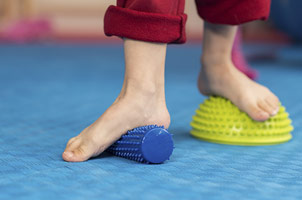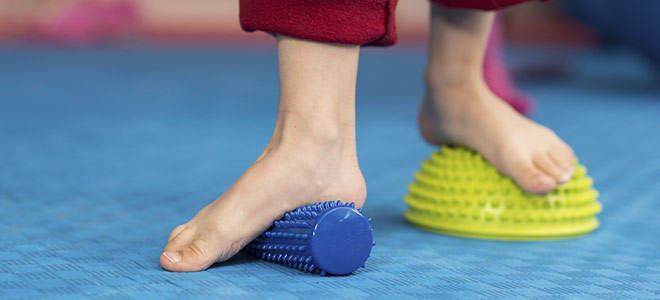Blog Categories
Search Blog
Blog Categories
How Can Physiotherapy Help My Child Who Has Autism?
When a child first receives a diagnosis of autism, it can be an extremely overwhelming and confusing time for parents. In the initial assessment report, often the first recommendations are for speech, behavioral and/or occupational therapy. Children who struggle with communication need to acquire these important skills first, prior to engaging in other types of therapy. However, recent research has stated that many children with autism also struggle with gross motor skills, low tone, gait abnormalities and motor planning. These concerns can vary in severity and may affect the child anywhere from a mild impairment to significantly impacting his/her quality of life. Physiotherapy can help in all of these areas!
Gross Motor Skills
Gross motor skills are defined as large movements using the arms, legs, torso and feet. Children with autism, on average, are approximately 6 months behind their typically developing peers with regard to their gross motor skills (MacDonald, Lord, & Ulrich, 2014). Why is this? Although gross motor skills do not rely on social context, they are often mastered by watching others and imitating what they are doing. This is an area where children with autism struggle, and may help to explain the reason for some of these delays. Other reasons that children with autism may be delayed in their gross motor skills include:
- Decreased attention/play skills
- Tactile sensitivities and aversions
Low Tone
Tone is described as the amount of tension in your muscles at rest. A child with high tone is often described as having ‘tight muscles that are difficult to move’, while a child with low tone is often described as ‘floppy, always leaning against something, unable to keep self upright without support’. Children with autism often have tone that is lower than average. What does that mean? Imagine your core (or tummy muscles) as a piece of uncooked spaghetti. If it is firm, it is easy to move your arms, pick up an object, and move around without falling over. Now imagine it as a piece of cooked spaghetti. If your core is looser, suddenly even the act of sitting up or picking an object off the floor requires considerable more energy then someone whose tone naturally rests at a higher level. Having lower tone can result in:
- Balance concerns
- Clumsiness, frequent falls, inability to keep up with peers
- Tiring easily or requiring more effort for simple tasks
Gait Abnormalities
Many children with autism are prone to walking abnormalities, the most common being toe walking. This is defined as walking up on the toes with no true heel contact with the floor. The average age of toe walking onset is around 18-24 months (which is, on average, when many children with autism start walking). Why is toe walking a problem? Toe walking can cause:
- Decreased endurance
- Decreased balance
- Altered biomechanics/abnormal gait pattern
- Tight calves
- Pain
- Calluses
- Weakness in the front of leg muscles
Motor Planning
Motor planning is the term used to describe your brains capacity to understand a motor action, figure out how to do it, involve the correct muscles/body parts, and execute the activity. If we take the example of walking across the room and break it down, you’ll find that it’s more complex than you actually think! First you must decide that you want to get up, you stand up coordinating the right movements, decide the speed at which to walk and cross the room. Now imagine that the room is crowded. Suddenly the seemingly simple plan of moving across the room isn’t so simple anymore! A simple plan has become more complex, requiring more thought, more planning and more muscle groups. We do this often without thinking twice about it. However, children with autism struggle with creating this plan, and executing it. When the plan becomes more complicated (for example, a crowded room) it can be overwhelming and cause children to bump into or trip over objects, because the environment has become so much more complex.
How Can Physiotherapy Help?
Physiotherapists are trained to help children in all of these physical areas. If the concern is a delay in gross motor skills, physiotherapists can offer exercises that you can do at home to help the child learn effective movement patterns, and improve balance and coordination, through functional play. If the issue is with gait concerns, physiotherapists can help teach your child how to stretch shortened muscles or strengthen weaker ones while working on overall gait biomechanics. While tone cannot be changed, as it’s inherent to the neurological system, strength can definitely be improved to compensate. Motor planning is also an area which can be improved with specific training and goal setting with both the parents and the child.
Physiotherapists often work closely within the multi-disciplinary team. Working together with SLP’s, OTs and psychologists is a great way to help your child make huge strides towards their goals; thus increasing self-esteem, function and improving overall quality of life.
Consult a physiotherapist if you have concerns in any of the above mentioned areas, and we would be happy to help!
Reference
Lloyd, Meghann, Megan MacDonald, and Catherine Lord. “Motor Skills of Toddlers with Autism Spectrum Disorders.” Autism : the international journal of research and practice 17.2 (2013): 133–146. PMC. Web. 22 Jan. 2016.






